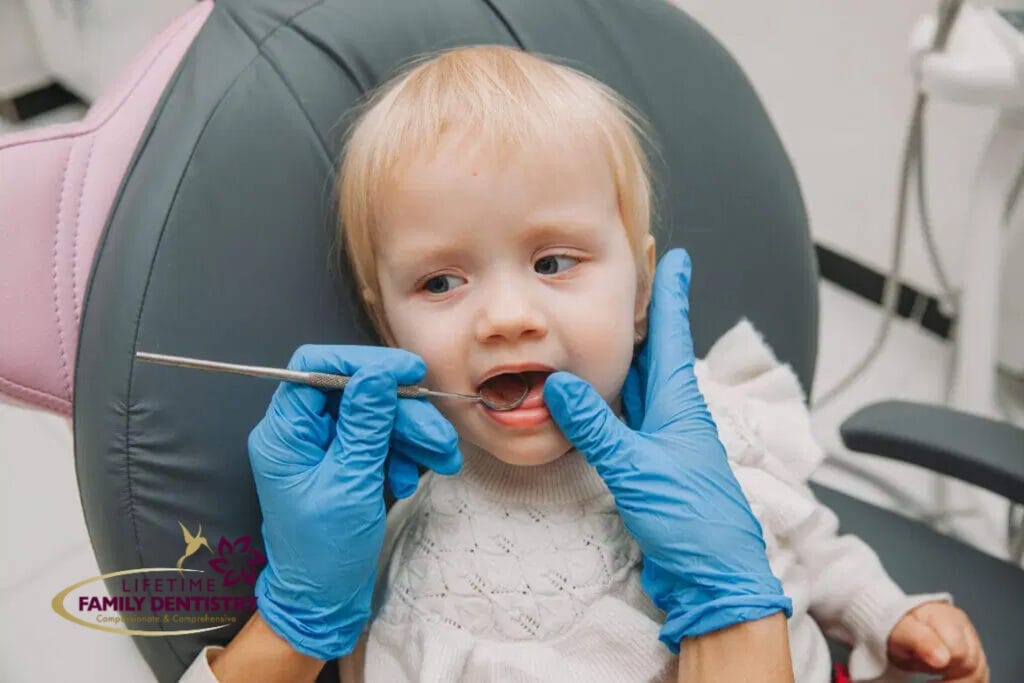Your smile’s journey deserves thoughtful care at every stage of life. Think of preventive dental care as an investment that pays dividends of comfort, confidence, and savings throughout your lifetime. With the right approach, your natural teeth can remain healthy companions for decades longer than you might expect.

Infancy (0-2 years)
Those precious first smiles deserve gentle protection right from the start. The American Academy of Pediatric Dentistry (AAPD) recommends the first dental visit by age one or within six months of the first tooth eruption—whichever arrives first. Before teeth emerge, a soft, damp washcloth becomes your ally in gently cleaning tender gums after feedings.
Those adorable baby teeth aren’t merely placeholders—they’re guiding future permanent teeth into position while supporting proper speech and nutrition. Protect them by avoiding the common pitfall of bedtime bottles filled with anything but water. Sweet liquids pooling around delicate teeth during sleep can lead to rapid decay that’s both painful and preventable.
Most little ones naturally bid farewell to pacifiers and thumb-sucking between ages 2-4, but if these habits linger beyond age 4, your dentist can recommend gentle intervention strategies that won’t create anxiety.
Early Childhood (3-5 years)
Preschool years bring newfound independence to the bathroom sink. A colorful child-sized toothbrush topped with just a pea-sized dollop of fluoride toothpaste makes the perfect introduction to self-care, though your guiding hand remains essential until around age 7.
Dental visits now evolve into more comprehensive experiences, with careful examinations revealing the unique story of your child’s developing smile. Professional fluoride treatments become valuable allies, creating a shield of protection significantly stronger than toothpaste alone can provide.
Nutrition choices during these formative years leave lasting impressions. Beyond the obvious sugary suspects lurk “hidden sugars” in seemingly innocent options like fruit juices and flavored yogurts. Balancing these with calcium-rich foods and crunchy fruits and vegetables helps build both healthy teeth and positive eating patterns.
School Age (6-12 years)
The magical years of tooth fairy visits typically begin around age 6 when lower front teeth start their gentle departure. Meanwhile, permanent molars make their quiet entrance at the back of the mouth, beginning the fascinating transition to a mixed collection of primary and permanent teeth.
This dynamic period presents the perfect opportunity for protective sealants—invisible shields applied to newly emerged permanent molars where decay loves to hide. These quick, painless applications reduce cavity risk by an impressive 80%, making them one of dentistry’s most effective preventive tools.
For young athletes, a properly fitted mouthguard becomes essential equipment, protecting more than just their smile during physical activities. An orthodontic evaluation around age 7 gives your dentist a preview of how teeth and jaws will develop, sometimes revealing opportunities for simpler early interventions.
Adolescence (13-17 years)
The teenage smile often temporarily features the sophisticated hardware of orthodontic treatment. Most teens begin this journey between ages 12-14 when permanent teeth have mostly arrived but jaw growth remains adaptable. Behind the scenes, wisdom teeth are developing, prompting important conversations about whether these third molars will have sufficient space to emerge properly.
Newfound independence often introduces dietary choices that can challenge dental health. Sports drinks, sodas, and acidic beverages become temptations that can silently erode enamel when consumed frequently. For teens with braces, maintaining oral hygiene requires extra dedication, with specialized tools becoming valuable allies in keeping teeth and gums healthy beneath brackets and wires.
Appearance awareness peaks during these years, making it an ideal time to discuss how healthy habits contribute to the naturally attractive smile they desire for the future.

Young Adulthood (18-35 years)
Life accelerates dramatically during these years, sometimes relegating dental care to the bottom of bustling to-do lists. Yet maintaining consistent preventive routines now prevents far more time-consuming and costly interventions later. Those who completed orthodontic treatment discover that retainers become their smile’s best friends, preserving beautiful results with minimal effort.
Career pressures and life transitions often reveal themselves in unexpected ways—including teeth grinding during sleep. A custom night guard becomes a wise investment, protecting enamel from damage while reducing morning headaches and jaw discomfort.
With financial independence comes the freedom to explore cosmetic enhancements that might have been previously out of reach. Professional whitening, bonding, and veneers offer options for addressing aesthetic concerns while preserving the health of natural teeth.
Middle Adulthood (36-55 years)
The smile now tells stories of years well-lived, sometimes revealing wear patterns that reflect your unique history. Preventive focus shifts toward preserving natural teeth and addressing early signs of age-related changes. Gum health demands increasing attention as periodontal disease risk rises significantly during these years.
Previous dental work often requires refreshing, with older fillings sometimes needing replacement with more substantial restorations like crowns. These provide protection against fractures while restoring optimal function to teeth that have served faithfully for decades.
The connection between oral health and overall wellness becomes increasingly apparent. Research continues to strengthen our understanding of how uncontrolled gum disease may influence heart health, diabetes management, and respiratory conditions. Comprehensive care now addresses these relationships through personalized preventive strategies.
Mature Adulthood (56+ years)
Your smile has been your faithful companion through countless conversations, meals, and photographs—and deserves specialized care to maintain its comfort and function. Many medications commonly prescribed during this stage can affect oral health, making honest discussions about your complete health history an essential part of dental visits.
For those with missing teeth, dental implants offer remarkable stability and function that previous generations could only imagine. Even at advanced ages, these options remain viable with adequate bone density, helping maintain both nutrition and confidence.
The wisdom of experience often includes adapting to changing needs. Modified tools like enlarged toothbrush handles and electric options can compensate for arthritic limitations, while professional care may shift to include more frequent preventive visits. Though Medicare doesn’t typically cover routine dental services, discussing financial considerations becomes an important part of maintaining oral health throughout your golden years.
Preventive Care Constants Throughout Life
From the first baby tooth to a mature smile, certain dental care principles remain steadfast companions on your oral health journey. While treatments adapt to each life stage, these foundational elements form the bedrock of lasting dental wellness, preventing problems before they start and preserving your natural smile for decades.
Recommended Check-up Frequency
Your smile benefits from a consistent rhythm of professional care throughout life. The familiar twice-yearly visit remains the gold standard for most patients, creating the perfect interval for catching small issues before they become significant problems. Some life chapters may suggest more frequent visits—pregnancy, managing diabetes, or a history of gum disease often benefit from additional professional attention.
Proper Brushing and Flossing Techniques
The daily ritual of oral care follows you from childhood through retirement. A soft-bristled brush held at a 45-degree angle to your gumline remains your most faithful ally, particularly when paired with two minutes of gentle attention twice daily.
Despite countless innovations, nothing quite replaces daily flossing for those crucial spaces between teeth where decay and gum disease often begin their silent progress.
Diet and Lifestyle Impacts
Your dietary choices write themselves upon your smile regardless of age. The frequency of sugar exposure rather than the total amount creates the most significant impact on dental health. Those who constantly sip sweetened beverages or indulge in daylong snacking face greater cavity risks than those who enjoy occasional treats.
Meanwhile, smoking casts long shadows over oral health, significantly increasing risks for gum disease and diminishing healing capacity.
Technology in Modern Preventive Care
Today’s preventive dental care bears little resemblance to previous generations’ experiences. Digital imaging reveals developing concerns with remarkable detail and significantly reduced radiation. Sophisticated detection tools identify decay at stages once invisible to the human eye.
Perhaps most revolutionary is dentistry’s shift toward biological approaches—understanding and addressing the unique bacterial balance, genetic factors, and early warning signs that predict future problems before damage occurs.
Investing in Your Lifelong Smile Journey
The path to exceptional dental health unfolds across decades, with each stage offering unique opportunities for smile protection. Regular professional care combined with consistent home habits creates a foundation that supports not just dental comfort but overall wellness throughout life.
Your smile tells the story of your health journey—make it one of thoughtful investment rather than costly repairs, allowing your natural teeth to remain faithful companions through life’s countless conversations, meals, and memorable moments.


